|
The Angelic Symphony
''The Angelic Symphony'' is a set of four sculptures by Leonard Woods in the chancel of St. Andrew's-Wesley United Church in Vancouver. The sculptures were commissioned in 1947 by Elisabeth Rogers, a founder of the Vancouver Art Gallery and Vancouver Symphony Orchestra. Woods worked closely with the minister of St. Andrew's-Wesley United Church, the Reverend Oswald W. S. McCall. Installation took place in July 1948. The sculptures depict four angels of the Bible, each representing a different type of musician: a cymbalist, a trumpeter, a flautist, and a cellist The cello ( ; plural ''celli'' or ''cellos'') or violoncello ( ; ) is a bowed (sometimes plucked and occasionally hit) string instrument of the violin family. Its four strings are usually tuned in perfect fifths: from low to high, C2, G2, D3 .... Woods' inspiration was drawn from Psalm 150, where God is praised with musical instruments, and the intention was to visually echo the church organ. The angels are re ... [...More Info...] [...Related Items...] OR: [Wikipedia] [Google] [Baidu] |
Leonard Woods (sculptor)
Leonard Archibald Woods (1919–2014) was a Canadian sculptor, art historian, musician, composer, and author. He is best known for his sculptures ''The Angelic Symphony'', as well as for being a co-founder of Langley Community Music School. Biography Woods was born on 13 November 1919 in Stonewall, Manitoba. His father worked at the nearby Stony Mountain Penitentiary. He studied under LeMoine Fitzgerald at the Winnipeg School of Art, where he also learned sculpture, graduating in 1940. During World War II he served in the Royal Canadian Air Force before being discharged in 1943. After his service, he further trained in sculpture with Emmanuel Hahn at the Ontario College of Art. Woods moved west to British Columbia where he re-opened the sculpture department at the Vancouver School of Art. In 1946, Woods exhibited three works with the British Columbia Artists Exhibition held at the Vancouver Art Gallery. Two years later, he created four bas-relief sculptures for the c ... [...More Info...] [...Related Items...] OR: [Wikipedia] [Google] [Baidu] |
Langley, British Columbia (district Municipality)
The Township of Langley is a district municipality immediately east of the City of Surrey in southwestern British Columbia, Canada. It extends south from the Fraser River to the Canada–United States border, and west of the City of Abbotsford. Langley Township is not to be confused with the City of Langley, which is adjacent to the township but politically is a separate entity. Langley is located in the eastern part of Metro Vancouver. History First Nations Throughout the last several millennia, the area that is now Langley Township was inhabited by various Stó:lo nations, including the Katzie and Kwantlen. There is limited recorded history from this time, as much was passed down through oral tradition rather than written documents. The Kwantlen were a major factor in the salmon trade that later operated out of the Fort Langley. Simon Fraser, while traveling through the Sto:lo territory in 1808 recorded the image of a Kwantlen village: Their houses are built of cedar p ... [...More Info...] [...Related Items...] OR: [Wikipedia] [Google] [Baidu] |
Sculptures In British Columbia
Sculpture is the branch of the visual arts that operates in three dimensions. Sculpture is the three-dimensional art work which is physically presented in the dimensions of height, width and depth. It is one of the plastic arts. Durable sculptural processes originally used carving (the removal of material) and modelling (the addition of material, as clay), in stone, metal, ceramic art, ceramics, wood and other materials but, since Modernism, there has been an almost complete freedom of materials and process. A wide variety of materials may be worked by removal such as carving, assembled by welding or modelling, or Molding (process), moulded or Casting, cast. Sculpture in stone survives far better than works of art in perishable materials, and often represents the majority of the surviving works (other than pottery) from ancient cultures, though conversely traditions of sculpture in wood may have vanished almost entirely. However, most ancient sculpture was brightly painted, ... [...More Info...] [...Related Items...] OR: [Wikipedia] [Google] [Baidu] |

